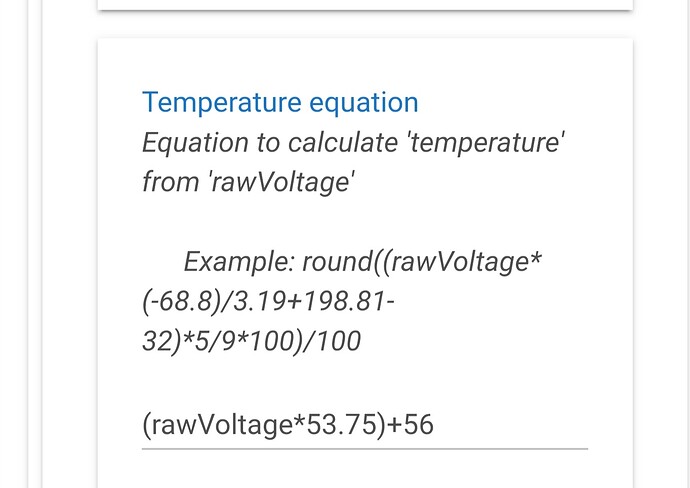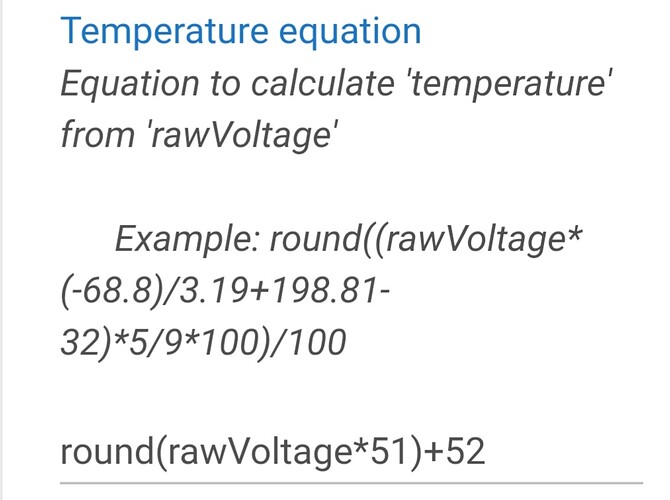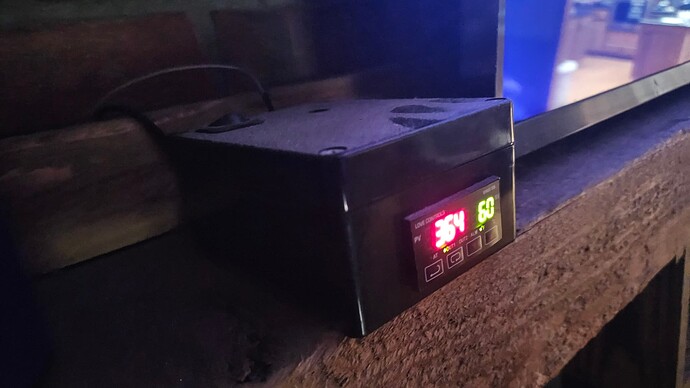I've used these at work (where it's not my money and reliability is key). If memory serves, it's close to $1,000. The version with a display is a couple hundred more.
I recieved this pid controller yesterday/early, and was looking through the manual. A couple of interesting points: the zero reset is able to be turned off on it, so it will not constantly adjust the output based on the difference between the process value and the set point. It will always maintain output at a 1:1 ratio with this turned off. Also, the output can be changed between heat and cool modes, so it will either increase or decrease voltage output in relation to input, depending on mode selected. There is also an offset value that can be applied to the output, in case the output needs to be within a certain voltage range.
Very cool. I'm much more confident I will be able to make this work in proportional control mode only.
I installed your driver using the package manager, but I am unable to see any actual values of the analog input sensor. I have input 1 operating mode set to 'analog input without internal pullup'. I have a strange feeling I did not install the driver correctly. Does this seem correct?
Edit: after rereading the driver thread again, I realized that it was user error after all. I installed the device, then your (much better) driver. I needed to hit the reinstall action. All good now. It's connected to the pid controller. I played with the proportional band settings until I was able to get a smooth linear voltage transition from just over 1 volts at 70 deg F, to 9.8 volts at just over 600 degrees F. I just have to figure out the calculation to temperature and put it in the settings and it's done.
Velvetfoot if you end up doing this, I was just thinking, you don't need a controller with 2 outputs. Let Hubitat take care of any additional outputs or alarms you need. The Smart Implant even has 2 relay outputs if needed.
I'm not going to use the relay output on this controller. I'm going to have Hubitat announce an overtemp situation on my Google Home minis, and push a notification to our phones. Even better than what I had before.
I don't think I'm going to depend on Hubitat for that.
A while ago I was having breakfast with a guy who, after loading his insert, set his SmartThings to turn on the fan when some temp sensor or other reached a certain temp. We were talking about it at breakfast, and then he realized it wasn't reacting, or something, so he had to rush on home. The fan wasn't on, but nothing burned down.
I realize that this controller is more what you're looking for, but what didn't you like about that amplifier thing you ordered?
Got it, I understand completely. Our stove is a freestanding unit, and we are careful not to overload it. We are also diligent not to leave the house or go to bed until the temperatures are on the decline. The fans on the stove and in the living room are not necessary in the safe operation in our setup. They are only used to better distribute the heat throughout the house. I am mainly interested in having them turn down or off when we are gone or asleep, when temps get down to, say, 175, as to not waste electricity.
You do bring up a good point, though. Maybe I should consider a buzzer wired directly into the pid relay output in the event that the air inlet is accidentally left open, as to not rely on zwave for a safety device.
I wish I had a free standing stove. The insert really needs that fan. I've used it during a power outage, but was very careful about not letting it get too hot. Doesn't put out much heat either.
A standalone alarm wouldn't hurt, if you have the contacts available. I'm using the two on my current pid already, as I said, one for high and one for low fan speeds.
I finally got around to mounting this controller in a plastic enclosure. I put a buzzer inside connected to to relay output in case of stove overtemperature. I have a 24v to 12v transformer board inside to run the 12v buzzer and the Smart Implant, which is mounted inside the enclosure as well. On the back I put a quick disconnect barrel connector for the 24v power in, and a quick disconnect for the thermocouple leads. Everything is working as it should. I can generally interpret the stove temperature by looking at the voltage level on the Hubitat dashboard, but I haven't been able to come up with a formula to input in the driver to convert the voltage to temp. It is not quite a 1:1 relationship. I was able to input my stove temps and corresponding voltage outputs from 100-600 degrees F into Google sheets.
Can anyone (who is better at math than me) figure out a way to convert this?
Thanks again for everyone's help and comments on this.
I monitor my grill temp with a k-type thermocouple probe. its works up to >1000c. I have it connected to an arduino MKR wifi 1010 with a MKR therm shield. Then I use the hubduino driver to bring it into hubitat.
there are other, cheaper thermocouple probes, but I already had several for monitoring grill/smoker that have the standardized plug the MKR therm accepts.
works great. I get a notification when my grill has preheated and when it has cooled down.
The thing I like about K-Type thermocouples is they are pretty corrosion resistant. Other common thermocouples have one element that is subject to corrosion.
Here is what I have come up with so far. It's within a few degrees of the pid readout at low to mid temps, but it deviates a little toward 600.
Ok I've finally come up with a formula that I am happy with. Hubitat is never more than 8 degrees F off from the readout on the controller, but is almost spot on in the couple of hundred degree range the stove is normally operated at.
In case someone stumbles on this thread at a later time, these were my settings for the Love Controls 32B-63LV connected to a k type tc
Temperature units to F
Ctrl to Pid
S-HC to cool
Input to k type thermocouple
Proportional band to 300
Integral time to 0
Derivative time to 0
Set point to 60 degF
Output 1 of pid connected to analog input 1 of Smart Implant.
Well, my Auber PID temp controller seems to have crapped out this morning-just a fluttering display of gibbersh. No amount of unplugging/plugging seems to help.
I guess I'll have to fly by the seat of my pants for a while, but I've really gotten used to looking at the digital display of stove top temperature.
Plus, the controller turned on the fan on low speed at a certain temperature, and turned it on high speed at a higher temperature (the fan has only two speeds).
I have to completely re-read this thread, to figure out how to proceed from here.
May I ask, would your controller have the capability of doing two switched outputs? If I remember correctly, my Auber has an alarm contact that I use for the high speed setting.
I really like that capability, for it doesn't matter what the Hub or Web is doing to work.
Thanks.
edit: And just like that, with some more fiddling, it seems to have started working again. I think I'm still going to pursue a replacement, since this is the second time this has happened, although last time one power cycle did it.
edit2: Still haven't re-read thread, but it looks like it could do it. $150. I have a Fibaro Smart Implant laying around (I hate those tiny wires) plus a power supply. I'm not good at prettying things up, but maybe I should start on on the project now, although heating season isn't optimal for this.
Yes, it has dual outputs from what i remember. It has been boringly reliable since I set it up a couple years ago. Also during heating season.
I put mine in a project box that sits on top of the mantle, with the Fibaro implant and alarm siren inside, with a mute switch mounted on top. I put quick disconnects on the thermocouple input and power supply input so i can quickly take it down and do repairs or modifications on the bench, which has not been needed. Knock on seasoned oak.
I re read the manual, and there is only one relay output on this unit. What if you used the Implant connected to the voltage output of the pid and have Hubitat control the output of your low speed fan using one of the output relays on the implant.
Then use the relay output of the pid to control the high speed fan (safer/not relying on Hubitat or Fibaro for the critical high speed fan control)
Thanks. Maybe the Alarm the blurb I copied refers to the little light on the panel. Indeed, only one relay. My Auber has a relay for an attached alarm, which is what I use for the high speed.
At this point, I have no idea how the fan is wired, only that it works. The Smart Implant, that tiny thing, controlling a motor directly? I think not. Add another relay? I'd just rather not get Hubitat or Fibaro involved in actual fan control anyway. I had a SI lose communication with the hub with a 1-wire sensor on a water storage tank. Perhaps the sensor, but it lost hub communication.
I'll look around some, or just replace in kind, if I can at this point.
Your setup is nice.
Thanks.
As sort of an aside to this topic, I forgot to turn on the switch to the fan after I loaded up with wood this morning. Needless to say, when I noticed, which really wasn't that long a time, it was well on its way to 1000 F! It was transitory, so I'm hoping no harm done, but an alarm would've been nice in addition to my existing control.
Also highlights possible concerns during a power outage. l would've gone with a free standing stove where these concerns are minimal, but there was an existing fireplace and floor space was at a premium.
Anyway, good morning, lol.
Yes an alarm is nice. Ive left my air intake open too far on accident before when getting a cold stove started. The obnoxious alarm siren alerted me that the load took off faster than expected.
Have you considered a insert? I have an unused standard fireplace in our office room that i was considering putting a stove insert in, but our Drolet freestanding unit does so well heating the house from the living room that i havent done so....yet. It's only on the extended below zero stretches of days that I am reminded (the sound of the furnace turning on).
Edit: nevermind, i just remembered you have an insert already.
I wish it was a stove.







